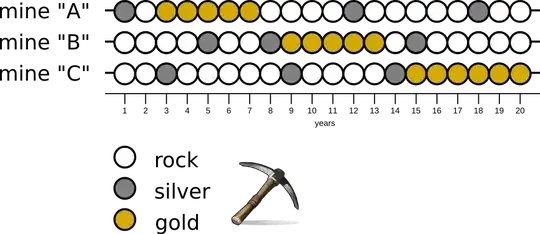Imagine a situation: We have historical records (20 years) of three mines. Does the presence of silver increases the probability of finding gold in next year? How to test such question?

Here is example data:
mine_A <- c("silver","rock","gold","gold","gold","gold","gold",
"rock","rock","rock","rock","silver","rock","rock",
"rock","rock","rock","silver","rock","rock")
mine_B <- c("rock","rock","rock","rock","silver","rock","rock",
"silver","gold","gold","gold","gold","gold","rock",
"silver","rock","rock","rock","rock","rock")
mine_C <- c("rock","rock","silver","rock","rock","rock","rock",
"rock","silver","rock","rock","rock","rock","silver",
"gold","gold","gold","gold","gold","gold")
time <- seq(from = 1, to = 20, by = 1)
